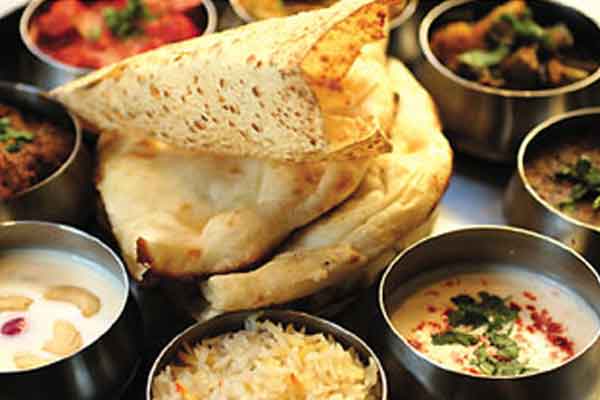Perfectly Balanced Indian Food : An Overview

India’s cuisine is as rich and diverse as her culture. But despite this diversity, there is one underlying unity — and that is the fact that all Indian food is perfectly balanced.
Now for a closer look at the historic and regional influences that have marked “India” a gourmet’s delight, in the map of the world.
PRE INDEPENDENCE :
Pre-Independence, India consisted of large areas of land directly ruled by the British, as well as about 600 semi-independent kingdoms ruled over by Hindu Maharajas and Muslim Nawabs, under British supervision.
INDEPENDENCE :
With Independence, the princely independent kingdoms were coaxed into merging with India. Each area with a distinct language and culture was given its own state. These separate cultures have their unique traditions that go back thousands of years. This is true of the foods and eating customs which differ from state to state.
THE FLAVORS AND TASTES OF INDIA :
Given India’s cultural, religious, ethnic, geographic and climatic diversity, it is impossible to describe Indian food under a single catch-all title. The British, in an overly simplified attempt, call all Indian food curry. But Indian food defies definition. The gracious art of hospitality coupled with the many tastes and flavors of India, definitely need to be experienced and savored.
CLIMATIC VARIATIONS
Appetite and digestive functions are directly related to climatic conditions.
The body bases its needs on environmental variations.
In the cooler parts of India, the body requires more heat, so heavier foods are required to fulfill this need. This is seen in regions such as Punjab and Uttar Pradesh, where the emphasis is on using substantial foods like ghee, paneer, rajma and wheat.
On the other hand, warmer and tropical climates of southern regions, such as Kerala, require lighter and easily digestible foods. This is why foods such as idlis, dosas, steamed rice and fish are popular. Most foods here are steamed and lightly cooked.
The western and eastern parts of India rely on local produces such as bajra, jawar, fish and coconuts from the coastal regions, to supply them with their nutritional requirements.
Isn’t it simply amazing to observe nature working in tandem with climatic conditions, producing foods based on the body’s requirements and providing just the right solutions to our nutritional needs!
SPICES
There are about 25 commonly used spices in Indian cooking. The essence of Indian cooking revolves around the use of spices. Spices act as both appetizers and digestives. These may be ground, roasted or made into a paste. The skill lies in the subtle blending of a variety of spices to enhance and add wonderful aromas and exotic flavors to the food.
CEREALS
All Indian food is served with either rice or bread or both. In the north, it is whole wheat breads, such as chapatti, parathas, rotis that are commonly eaten, and in the south it is plain rice and rice-based cereals. Western and Eastern India draw a mix of both.
TEA :
Tea is the symbol of Indian hospitality. One could easily call it the national beverage of India. Often spices such as pepper, cardamom, ginger, saffron, cinnamon and fresh mint leaves are added to enhance the flavor of tea. These spices have therapeutic benefits, for example, ginger and mint help digestion.
A CULINARY TOUR
NORTH : PUNJAB :
Local produce: The vast wheat fields of Punjab could be called the granaries of the nation. Most Punjabis have close ties to farms. Some of Punjab’s best food is hearty country fare, based on fresh wholesome milk, buttermilk, ghee and freshly harvested produce.
Punjabi food has a strong influence in India’s capital, Delhi.
An example of a popular meal in Punjab is a local produce mustard greens (sarson ka saag) and corn bread (makkai ki roti). This dish is best enjoyed in winters when the mustard greens are in full bloom. Also popular are parathas or tandoori rotis stuffed with vegetables like grated radishes, fenugreek and cottage cheese. Lentils such as black-eyed beans or kidney beans simmered long over slow fires and the dhaba special, chana-bhatura (stewed chickpeas) served with fried Indian bread are commonly eaten. A tall glass of buttermilk usually accompanies a meal.
It would be no exaggeration to say that the gourmet in you will not be satisfied until you have tandoori delights discovered for yourself. Unique to the north, the tandoor is a clay oven whose fuel is burning coals. The joy of partaking in this cuisine is that minimal oil is used in the cooking process and you get abundance of flavor without the additional calories.
Wheat and lentils contain all the essential amino acids; they are good sources of protein and carbohydrate.
Green vegetables are rich in Vitamins A and C and contain iron and magnesium.
Milk products are good sources of calcium and also provide the body with the necessary amino acids.
SOUTH : KERALA :
Local produce: Rice from the lush rice paddies. Black pepper, cinnamon, clove and tamarind, coconut, curry leaves and jackfruit.
The south does a great deal of its cooking over steam, as a result of which all homes are equipped with steaming pots. Idlis, dosas, rice puttu (glutinous rice powder steamed) and sambhar or rasam are popular breakfast foods.
“Stew” made with lamb, chicken, vegetables or potatoes, simmered gently in coconut milk and flavored with spices are eaten with appams. Appams, kallappams or wellapams, are rice flour pancakes designed to have soft, thick, white centres and thin, crisp, lace-like edges.
Besides appams and stew, meat, fish, vegetables and rice are popular. No meal is complete without rice.
The Moplas of Kerala serve excellent rice pilafs or pullaos. The Keralaiteshave modified this to suit their tastes and conditions. On this coastal strip, the most favored pilaf is studded with Arabian Sea prawns, subtly flavored with coconut milk.
Meals in the south are commonly steamed and centered around the consumption of rice, making them healthy, light and nourishing.
Fish contains essential nutrients Vitamin A and D. These are essential fats, which provide the body with energy and improve the metabolism. Intake of fish also helps lower cholesterol levels.
Rice and lentils are rich in calcium, consisting of ample protein and sufficient complex carbohydrates.
EAST: BENGAL :
Local produce : Fresh water fish from the rivers and lakes of Bengal.
Mustard oils and mustard seeds are used for cooking.
“I’m cooking some elish,” says the Bengali lady. Elish – or hilsa – is a fish. All Bengalis are passionate about food – especially fish, rice and sweets. Savoring a meal is an important event for them.
A typical meal consists of rice, dal and bhaja (a savoury made out of fish, vegetables or potatoes), fish curry, aam jhol (a thin soup made out of green mangoes) and mishti doi (thick sweetened curds) to satisfy the sweet tooth.
Fish contains essential nutrients Vitamin A and D, essential fats that provide the body with energy and improve the metabolism. Intake of fish also helps lower cholesterol levels.
Rice provides the body with the necessary carbohydrates.
Milk products are good sources of calcium and also provide the body with the necessary proteins.
WEST : GUJARAT
Local produce: In Saurashtra, the climate is dry. The fields grow peanuts, stalks of millet, wheat, sesame seeds and lots of tall sugarcane.
The majority of people in this region are vegetarians. A typical Gujarati meal consists of rice, dal, two vegetables, curds and pickle. Much of the food is based on grains, beans, roots and vegetables. Millet is a staple grain that grows here; it is high in protein, Vitamin E and iron, and low in carbohydrate and fat. Another popular bread is the thepla, rich in iron, calcium, protein and carbohydrates. Made ofwheat, it is mixed with spinach/ greens/ vegetables and made into a dough, then formed into a chapatti. This is eaten with green chutney, pickle or curds.
WEST : MAHARASHTRA
Local produce: Coconut, jawar, nachni, bajra
The vegetables here are more or less steamed and lightly seasoned so as to retain their nutritional value. Coconut is an important ingredient used for cooking.
A typical meal consists of bhakri (chapatti made of jawar or bajra or nachni), a green vegetable, vegetable curry, varan (lentil), rice, koshimbir (salad) accompaniments and curds or buttermilk.
The combination of lentil with carbohydrates like chapatti or rice, provides
necessary intake of protein and carbohydrates.
Vegetables provide essential Vitamins, minerals and fiber.
Fats are found in coconut or peanuts or cooking oils.
Milk products are good sources of calcium and also provide the body with the necessary amino acids.
THE BALANCED INDIAN THALI: AN OVERVIEW OF THE REGION’S CUISINE
Each region has is own local produce, culinary heritage and traditions. One best way to sample this is the thali (food served on a large rimmed stainless steel or metal plate or a banana leaf). Thali choices are plenty – North, South, East or West Indian. This form of eating is common in most parts of India.
This traditional meal comprises of vegetables or meats, pulses or dals, salad or kachumbar, rice or Indian breads, curds, accompaniments such as pickle or chutney and a dessert.
THE INDIAN AFTER-MINT
Paan is served as a digestive after some meals. The dark green leaf of the betel plant is smeared with a little lime and wrapped around a combination of spices such as crushed betel nuts, cardamom, aniseed, sugar and grated coconut.
Traditional Indian meals not only satisfy the palate, but also provide ample health benefits. The thali consists of a good mix of carbohydrates, proteins, fats and nutrients. It not only satisfies your taste buds but is a perfectly nutritionally, balanced sample of the Indian meal.
Indian food is elaborate, painstaking, and complete; whereas in the Western world the emphasis is on quick, easy cooking and practical one-meal dishes.
How fortunate, then, we are to live in a land where meal times are a warm, pleasurable and wholesome experience, serving as a well-deserved break to get away from the everyday stresses of living.
INTERESTING FACTS
- All spices and herbs have medicinal properties. Turmeric, for example, is an antiseptic; perhaps that is why it is applied to fish before it is fried. Garlic is good for circulatory ailments, coriander and tamarind for constipation and cloves are good for the heart.
- In the mountain-clad region of Kashmir, a green tea similar to Chinese tea, called kahara, is popular it is served sprinkled with almonds and cinnamon, ingredients known to warm the body.
- The inherent heating and cooling properties of food determine which time of the year the will be served. For example, curds or yogurt is popularly consumed in summer and nuts and dried fruits, in winter.
- In tropical Tamil Nadu, tamarind is commonly used as it has cooling properties.
- Much of the south uses its temperature very cleverly to take care of some of the culinary details. Many staple dishes such as idlis, require fermentation. No yeasts are used, as the mean temperature of about 80 degrees F (25 degrees C) does the work quite effortlessly.
- A variety of fruits are available in different regions; they are truly nature’s gift to mankind. Apples, oranges and bananas are generally available almost all year round. The banana is the most commonly eaten fruit in India. It is economical, nourishing and easily accessible.





